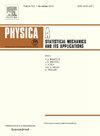Analysis of the impact of heterogeneous platoon for mixed traffic flow: A fundamental diagram method
IF 2.8
3区 物理与天体物理
Q2 PHYSICS, MULTIDISCIPLINARY
Physica A: Statistical Mechanics and its Applications
Pub Date : 2025-01-22
DOI:10.1016/j.physa.2025.130398
引用次数: 0
Abstract
In the first part of this study, different combination spacing control strategies for platoons are proposed. The combined performance of different strategies in terms of fuel consumption and emission is evaluated by numerical experiments. However, that study mainly focused on assessing the environmental benefits of the strategies and did not deeply explore the traffic flow characteristics under different spacing strategies. Therefore, the second part of this study focuses on analyzing the fundamental diagram of mixed traffic flow to explore further the effects of different control strategies on traffic flow characteristics. Firstly, the fundamental diagram models of mixed traffic flow under ten control strategies are established based on the three-parameter relationship of traffic flow and the definition of density. Subsequently, the theoretical fundamental diagrams are verified by numerical simulation experiments, and the effects of different control strategies on the average speed and capacity of mixed traffic flow are analyzed in detail. Finally, the sensitivity analysis of the free flow speed and the minimum safety spacing is carried out based on the fundamental diagram model. The results show that (1) introducing the CS strategy can significantly improve capacity, and the combination with the VTG strategy has the best effect. When the penetration rate of CAVs is 1, the maximum traffic capacity of the VTG1-CS strategy is close to 10,000 veh/h, which is more than 5 times that of the HV homogeneous traffic flow, while the enhancement of the CTG-CS strategy is about four times. (2) The maximum traffic capacity of the VTG2-CS strategy when the penetration rate of CAVs is 1 is about 110.69 veh/h less than that of the CTG-CS strategy, but it performs better in terms of overall traffic flow in traffic density. However, the BS-CS strategy is weaker in enhancing traffic capacity. (3) The VTG1-CS strategy is the most sensitive to free flow speed, followed by the CTG-CS strategy. In contrast, the VTG2-VTG2 strategy is the least sensitive to free flow speed, and the VTG2-CTG and VTG2-CS strategies based on this strategy are also less sensitive. Finally, the VTG2-VTG2 strategy and VTG2-CS strategy have the highest sensitivity to the minimum safety spacing parameter. To sum up, this study provides a theoretical basis for the mechanism of the effects on traffic flow characteristics with different spacing control strategies in mixed traffic flow.
求助全文
约1分钟内获得全文
求助全文
来源期刊
CiteScore
7.20
自引率
9.10%
发文量
852
审稿时长
6.6 months
期刊介绍:
Physica A: Statistical Mechanics and its Applications
Recognized by the European Physical Society
Physica A publishes research in the field of statistical mechanics and its applications.
Statistical mechanics sets out to explain the behaviour of macroscopic systems by studying the statistical properties of their microscopic constituents.
Applications of the techniques of statistical mechanics are widespread, and include: applications to physical systems such as solids, liquids and gases; applications to chemical and biological systems (colloids, interfaces, complex fluids, polymers and biopolymers, cell physics); and other interdisciplinary applications to for instance biological, economical and sociological systems.

 求助内容:
求助内容: 应助结果提醒方式:
应助结果提醒方式:


